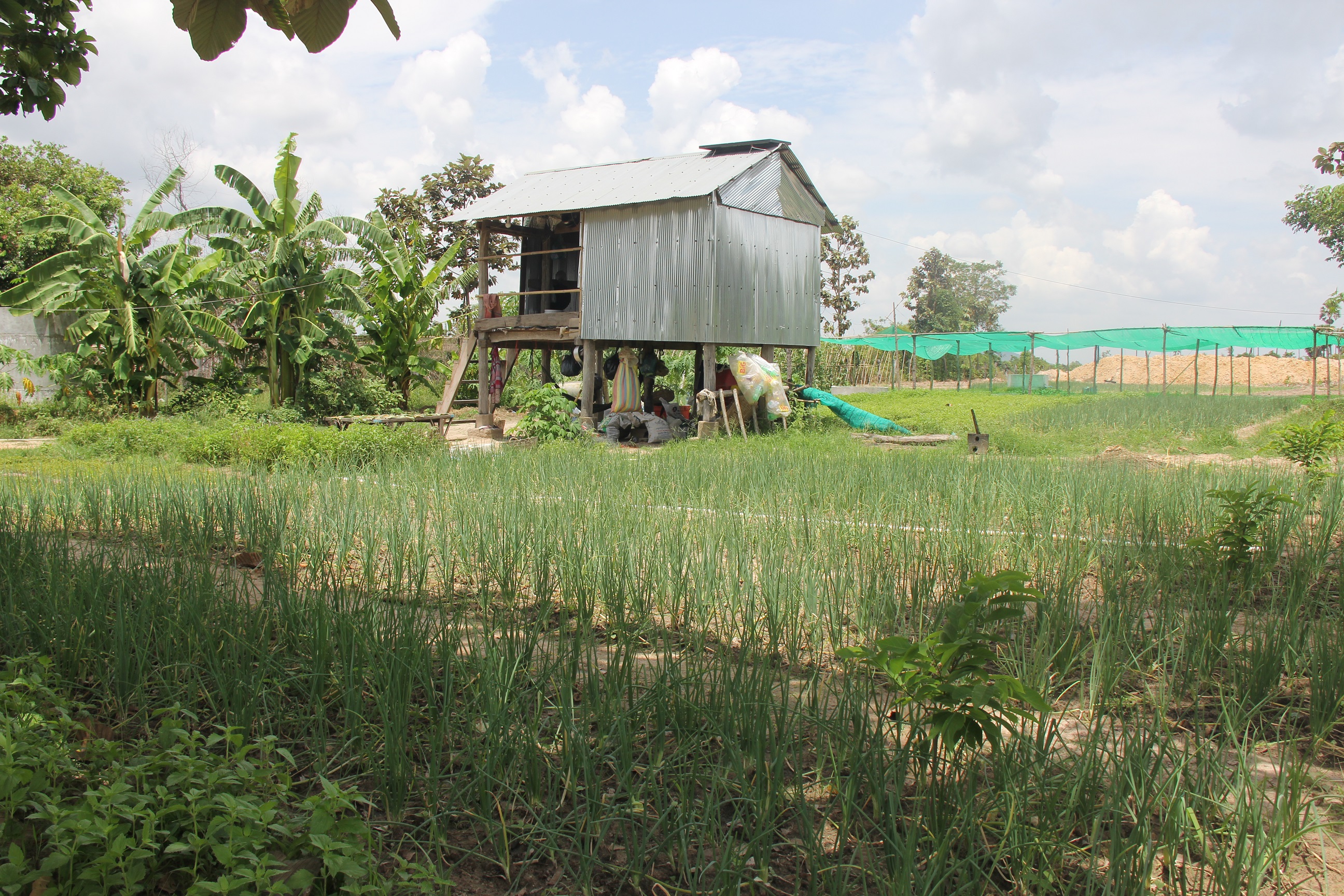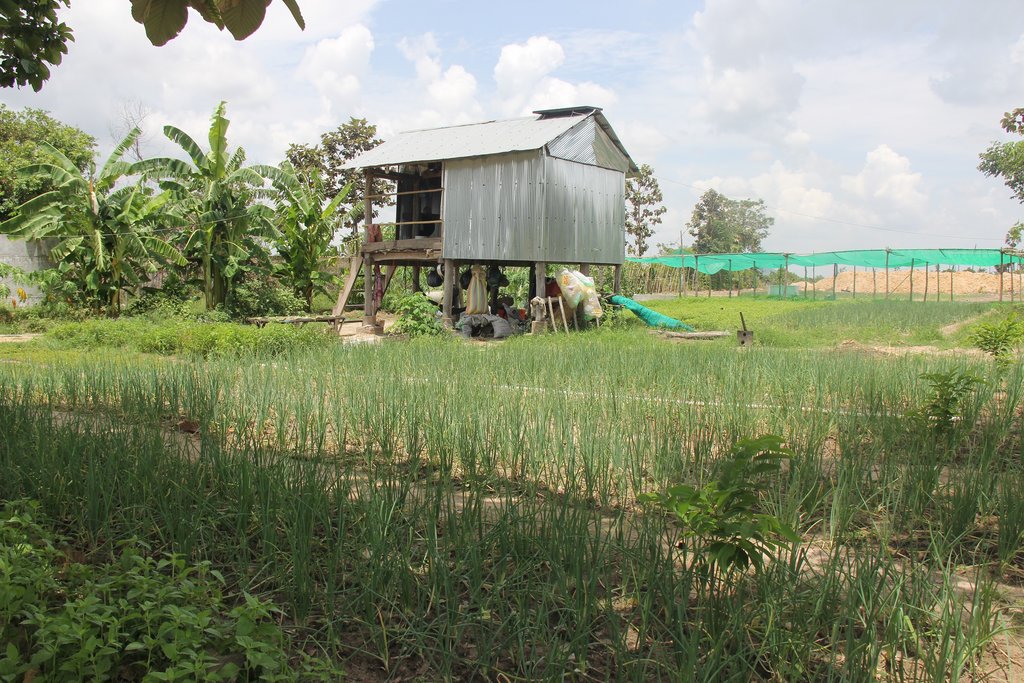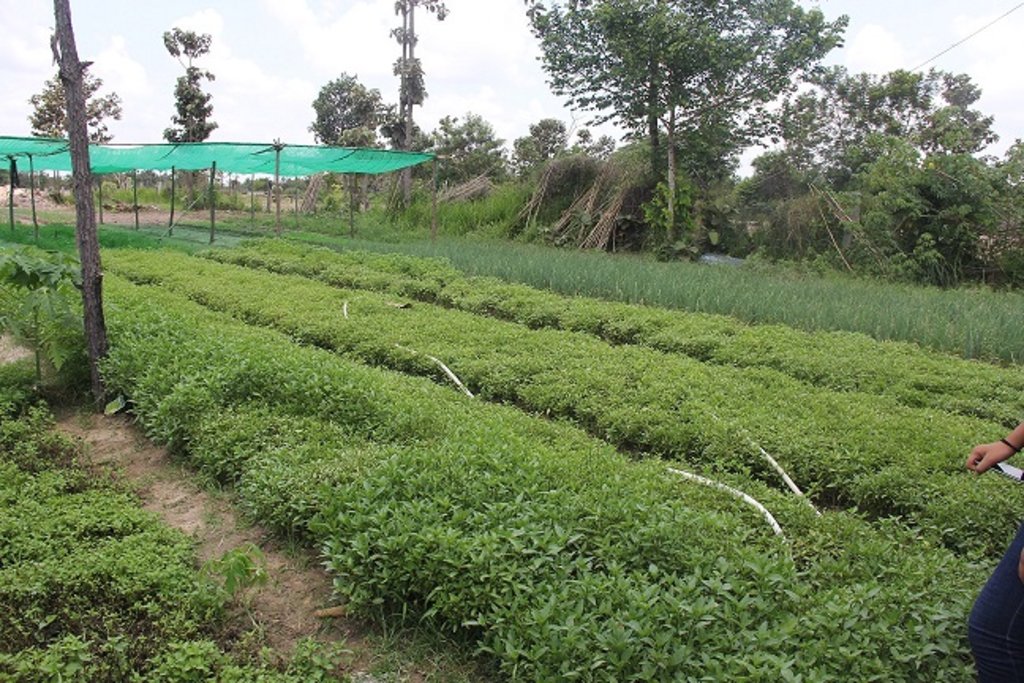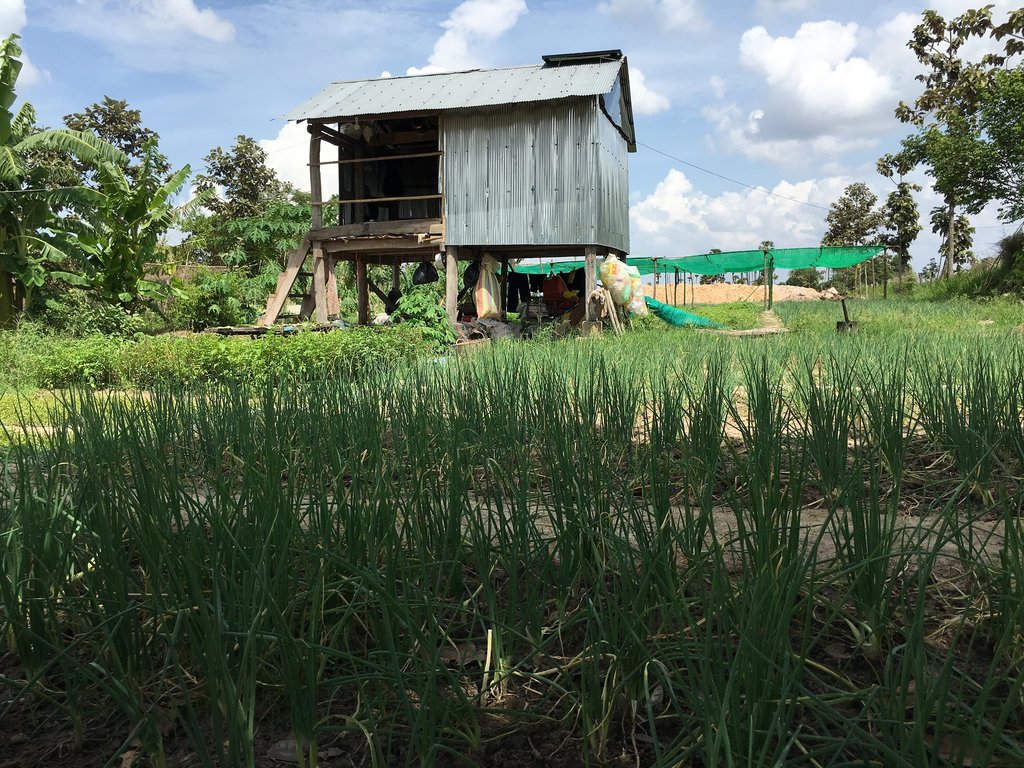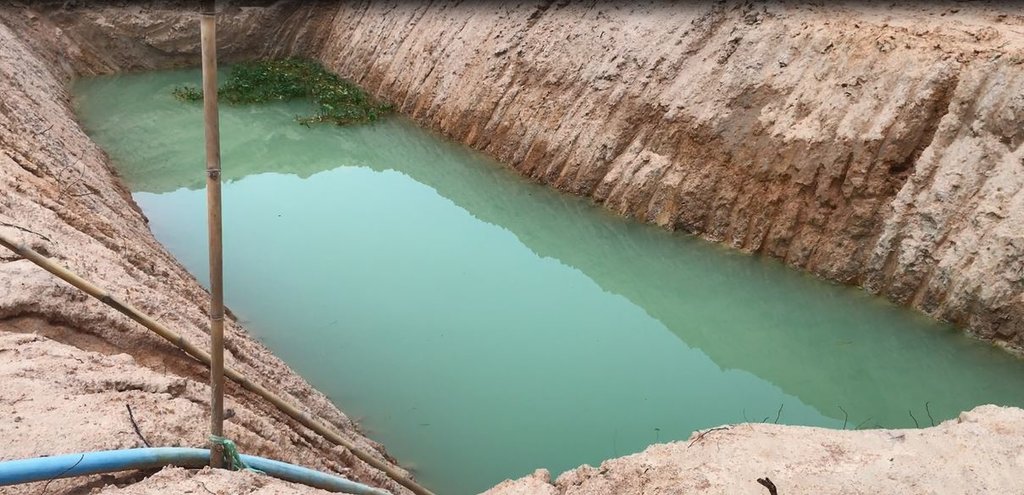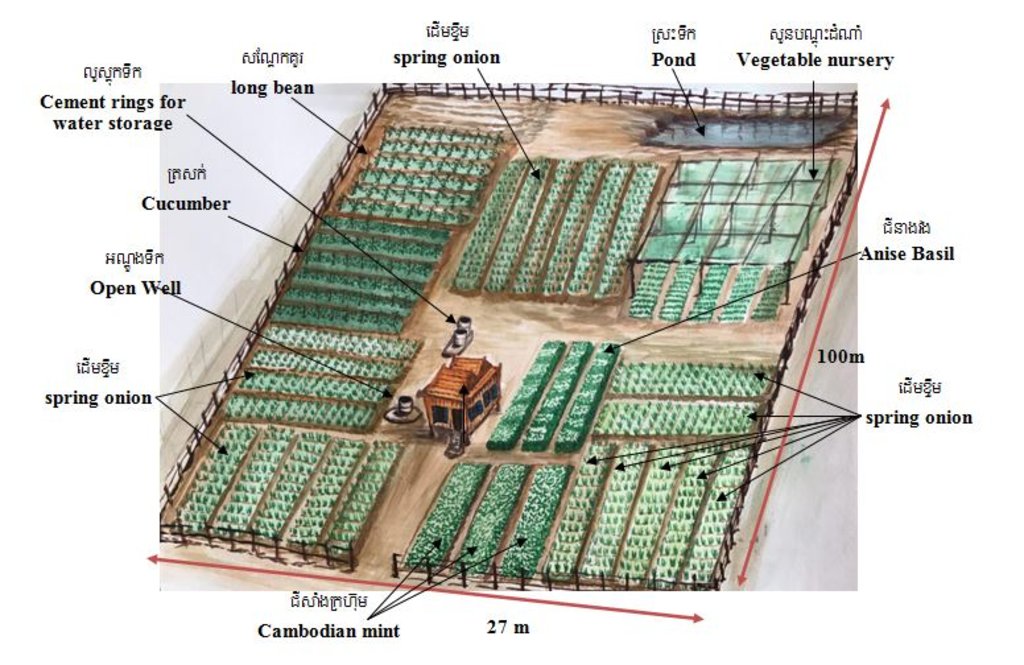Crop diversification with the application of rotation techniques [Cambodia]
- Creation:
- Update:
- Compiler: Navin Chea
- Editors: Sophea Tim, Sok Pheak
- Reviewers: Nimul CHUN, Ursula Gaemperli, Alexandra Gavilano
Crop diversification farm
technologies_3145 - Cambodia
View sections
Expand all Collapse all1. General information
1.2 Contact details of resource persons and institutions involved in the assessment and documentation of the Technology
Key resource person(s)
land user:
Phrum Thon
Land User
Cambodia
Vice Chief of Agronomy Office at Agricultural Office of Rolea B'ier:
Chhim Bunleang
Agricultural Office of Rolea B'ier.
Cambodia
Vice Chief of Agricultural Extension Office at Provincial Department of Agriculture, Forestry and Fisheries, Kampong Chhnang province:
Chief of Agricultural Office of Tuek Phos:
Name of project which facilitated the documentation/ evaluation of the Technology (if relevant)
Scaling-up SLM practices by smallholder farmers (IFAD)Name of the institution(s) which facilitated the documentation/ evaluation of the Technology (if relevant)
Royal University of Agriculture (RUA) - Cambodia1.3 Conditions regarding the use of data documented through WOCAT
The compiler and key resource person(s) accept the conditions regarding the use of data documented through WOCAT:
Yes
1.4 Declaration on sustainability of the described Technology
Is the Technology described here problematic with regard to land degradation, so that it cannot be declared a sustainable land management technology?
No
2. Description of the SLM Technology
2.1 Short description of the Technology
Definition of the Technology:
Crop diversification is the practice of simultaneously cultivating two or multiple varieties of crops in a given area whilst at the same time applying crop rotation and/or intercropping. In this case study the land user has been practicing crop diversification with eleven different crop varieties.
2.2 Detailed description of the Technology
Description:
Crop diversification entails simultaneously growing two or multiple varieties of crops in a particular place with the application of crop rotation techniques and/or intercropping. The selection of the crop varieties will depend on the purpose of the land user. In general, a diversity of crops will provide a range of benefits such as food security, nutritional diversity, income generation, soil conservation, pest and disease control as well as adaptation to climate change (CGIAR, 2017, Makate et al, 2016, MoEYS& VVOB Cambodia, 2013).
Mrs. Prum Thon has been cultivating a diversity of crops with the application of rotation techniquesfor about 10 years, which involves exchanging an entire crop in a particular row. This means that cultivation can take place throughout the year without having to leave the land fallow. At the time of the interview eleven different crops had been cultivated including spring onions, anise basil, Cambodian mint, bok choy, choy sum, escarole, mint, long beans, cucumbers, bitter melons and lettuce. Almost all of these crops have an average lifespan of three months, except for the anise basil which can grow for one or two years depending on the way it is cultivated. After she has harvested a particular crop, she will then rotate this crop row with a new distinctive crop species. For instance after having harvested spring onions she will then plant mint in that row, and in the row where she was previously growing mint, she will rotate that with either spring onions or cucumbers.
The practice of crop diversification whilst at the same time rotating the crop in each of the rows aims to achieve the following main objectives:
Crop diversification enables the farmer to generate a daily income to offset her daily expenses which thereby becomes a means of improving her livelihood. Growing a diversity of crops can also enable her to meet a variety of market demands and generate a high daily income. If a farmer grows only one crop specie she can usually earn about 15,000 Riel per day, but if she plants four crop species such as anise basil, bok choy, long beans and cucumbers she can increase her income to about 20,000 Riel per day, However if she grows one more specie such as lettuce or grows eleven different crops, she would be able to increase her income up to 40,000 or 80,000 Riel per day. The practice of crop diversification enables her to generate an income on a daily basis.
Crop diversification with the rotation of the crop in each row after the harvest could assist in reducing soil degradation. According to her experience and observations each crop absorbs different nutrients from the soil. If one row is repeatedly used to cultivate spring onions, they tend not to flourish so well and the roots have a tendency to decay. However if they are rotated with another crop and the spring onions are then grown in another row, they are able to thrive and the roots and stems are less likely to spoil. Crop diversification also has other functions as the cover crops help to reduce soil degradation through expose to sunlight, maintain soil moisture, make the soil less compact and add beneficial micro-organisms to the soil. In addition crop diversification can control pests especially the practice of growing companion plants such as herbs or spring onions as this can prevent crops from being damaged by pests.
The use of this technology assists in improving livelihoods, reduces migration because she does not need to move in order to find a job in another location, and enables her to generate a daily income. In addition this technology is able to reduce the risk of crop failure resulting from damage by pests and insects.Furthermore it reduces the risks associated with changes in market demand as the farmer produces a diversity of crops and also it prevents and reduces soil degradation. In order to effectively use this technology there needs to be sufficient water supply such as a river, stream, well or pond.This enables the land user to grow crops throughout the year round and reduces damage of crops as the result of unpredictable adverse climate conditions such as changes in rainfall, or the occurrence of drought.
2.3 Photos of the Technology
2.5 Country/ region/ locations where the Technology has been applied and which are covered by this assessment
Country:
Cambodia
Region/ State/ Province:
Ruessei Duoch village, Banteay Peal Commune, Rolea B'ier District, Kampong Chhnang Province.
Specify the spread of the Technology:
- evenly spread over an area
If the Technology is evenly spread over an area, specify area covered (in km2):
0.0027
If precise area is not known, indicate approximate area covered:
- < 0.1 km2 (10 ha)
Comments:
It is spread over an area of 2700 square meters.
Map
×2.6 Date of implementation
If precise year is not known, indicate approximate date:
- 10-50 years ago
2.7 Introduction of the Technology
Specify how the Technology was introduced:
- through land users' innovation
- during experiments/ research
- through projects/ external interventions
Comments (type of project, etc.):
Through her experience and training from Cambodian Center for Study and Development in Agriculture (CEDAC).
3. Classification of the SLM Technology
3.1 Main purpose(s) of the Technology
- improve production
- reduce, prevent, restore land degradation
- create beneficial economic impact
3.2 Current land use type(s) where the Technology is applied

Cropland
- Annual cropping
Annual cropping - Specify crops:
- vegetables - root vegetables (carrots, onions, beet, other)
- vegetables - melon, pumpkin, squash or gourd
- vegetables - leafy vegetables (salads, cabbage, spinach, other)
- legumes and pulses - beans
- medicinal/ aromatic/ pesticidal plants and herbs
- cucumber
Annual cropping system:
Vegetables - wheat/barley/oat/upland rice
Number of growing seasons per year:
- 3
Specify:
Crop rotation throughout the whole year. The land is alway coverd by corps (no fallow period).
Is crop rotation practiced?
Yes
Comments:
Spring onion, anise basil, Cambodian mint, bok choy, escarole, choy sum, mint, long bean, cucumber, bitter melon, lettuce.
3.3 Has land use changed due to the implementation of the Technology?
Has land use changed due to the implementation of the Technology?
- Yes (Please fill out the questions below with regard to the land use before implementation of the Technology)

Forest/ woodlands
Comments:
Degraded forest land.
3.4 Water supply
Water supply for the land on which the Technology is applied:
- mixed rainfed-irrigated
Comments:
There is one open well and a pond for crop irrigation during drought.
3.5 SLM group to which the Technology belongs
- rotational systems (crop rotation, fallows, shifting cultivation)
- integrated soil fertility management
- integrated pest and disease management (incl. organic agriculture)
3.6 SLM measures comprising the Technology

agronomic measures
- A1: Vegetation/ soil cover
- A2: Organic matter/ soil fertility

structural measures
- S5: Dams, pans, ponds

other measures
Comments:
The farmer grows specific companion plants on the same plot with the aim of improving the plant growth and the pest control.
3.7 Main types of land degradation addressed by the Technology

chemical soil deterioration
- Cn: fertility decline and reduced organic matter content (not caused by erosion)

physical soil deterioration
- Pc: compaction

biological degradation
- Bc: reduction of vegetation cover
- Bs: quality and species composition/ diversity decline
- Bl: loss of soil life
- Bp: increase of pests/ diseases, loss of predators
3.8 Prevention, reduction, or restoration of land degradation
Specify the goal of the Technology with regard to land degradation:
- prevent land degradation
- reduce land degradation
Comments:
At the first time when she cultivated the land the soil was fertile. At that time she grew only cassava but she realized soon that if she grows always the same crop, the soil will be less fertile from year to year.
4. Technical specifications, implementation activities, inputs, and costs
4.1 Technical drawing of the Technology
Technical specifications (related to technical drawing):
The total area on which the technology has been applied amounts to 2700 square meters (27 meters x 100 meters). Each of the diverse crop species such as spring onions, anise basil, bok choy, choy sum, escarole, Cambodian mint, long beans, bitter melons and lettuce have been divided into separate blocks.
The spring onion crop has been divided into 5 blocks out of which the first block measures 8.50 m x 8.50 m = 72.25 square meters and it contains a total of five rows. The length of each row is 8.50 m and width is 1.4 m and space between each row is 4 centimeters. The second block measures 14.60 m x 13 m= 189.3 square meters and it has been divided into two rows. Each row is 14.60 m in length and has a width of 1.4 m with a space of 4cm between the two rows. The third block measures 9.60 m x 3.90 m= 37.44 square meters and it contains 6 rows. Each of the rows is 9.60 m x 1.4 m and the space between each of the rows is 4 cm. The fourth block measures 6.35 m x 4.55 m= 28.89 square meters and it is divided into 4 rows. Each of the rows is 6.35 m in length and 1.4 m in width, and the space between each of the rows is 4 cm. The fifth block measures 11.60 m x 14.70 m = 170.52 square meters and it contains 6 rows. Each of the rows is 11.60 m in length, and 1.5 m in width and the space between each of the rows is 4 cm.
The block in which the anise basil is grown is 14.60 meters in length and 1.4 meters in width with a 4 cm space between the 3 rows. The block of cucumbers is divided into 6 rows with the length of each row being 10 meters and the width being0.5 meters. Each row rises to a height of about 1.5 cm and within the row the space between each cucumber clump is 0.5 cm. In the block of the long beans there are 6 rows with each row being 10 meters in length and 0.5 meters in width. Additionally the height of each row is 1.5 cm and space between each clump of long beans is 2 cm.
The nursery containing escarole, choy sum and lettuce is 14.60 meters x 13.50 meters and its roof has a height of 2 meters. There are two cement rings which also have a cement base that have been constructed for water storage. Each cement ring is 1 meter in height and 1 meter in diameter. Furthermore there is also one open well and a pond which provide water for domestic supply and the irrigation of crops.
Author:
Mr. Khoun Sophal
Date:
22/05/2017
4.2 General information regarding the calculation of inputs and costs
Specify how costs and inputs were calculated:
- per Technology area
Indicate size and area unit:
2700 square meters
other/ national currency (specify):
KHR
If relevant, indicate exchange rate from USD to local currency (e.g. 1 USD = 79.9 Brazilian Real): 1 USD =:
4000.0
Indicate average wage cost of hired labour per day:
15000
4.3 Establishment activities
| Activity | Timing (season) | |
|---|---|---|
| 1. | Dig open well | During dry season |
| 2. | Dig pond | During dry season |
| 3. | Plough the soil two times and dry the soil by sunlight | After harvest |
| 4. | Buy crop seeds | At the beginning of soil preparation |
| 5. | Prepare pipe lines into cement rings | At the beginning of soil preparation |
| 6. | Buy net to cover the roof of the nursery house | At the beginning of soil preparation |
| 7. | Buy materials such as spit, handled basket, hoe ect | At the beginning of soil preparation |
4.4 Costs and inputs needed for establishment
| Specify input | Unit | Quantity | Costs per Unit | Total costs per input | % of costs borne by land users | |
|---|---|---|---|---|---|---|
| Labour | Plough the soil for the first and second time | person-day | 11.0 | 15000.0 | 165000.0 | 100.0 |
| Labour | Clear land for growing 11 different crops | person-day | 15.0 | 15000.0 | 225000.0 | 100.0 |
| Labour | Dig the open well and put the cement ring | person-day | 84.0 | 15000.0 | 1260000.0 | 100.0 |
| Labour | Dig pond | person-day | 133.0 | 15000.0 | 1995000.0 | 100.0 |
| Equipment | Bamboo sticks | Piece | 50.0 | 1500.0 | 75000.0 | 100.0 |
| Equipment | Hoe | Piece | 2.0 | 17000.0 | 34000.0 | 100.0 |
| Equipment | Spit | Piece | 2.0 | 1300.0 | 2600.0 | 100.0 |
| Equipment | Handle basket to carry soil | Pair | 1.0 | 6000.0 | 6000.0 | 100.0 |
| Plant material | Spring onion | Kilogram | 10.0 | 1000.0 | 10000.0 | 100.0 |
| Plant material | Bok choy | Can | 12.0 | 1500.0 | 18000.0 | 100.0 |
| Plant material | Escarole | Package | 2.0 | 10000.0 | 20000.0 | 100.0 |
| Plant material | Choy Sum | Can | 5.0 | 1500.0 | 7500.0 | 100.0 |
| Plant material | Anise basile | Package | 1.0 | 15000.0 | 15000.0 | 100.0 |
| Plant material | Mint | Kilogram | 3.0 | 4000.0 | 12000.0 | 100.0 |
| Plant material | Cambodian mint | Kilogram | 2.0 | 2500.0 | 5000.0 | 100.0 |
| Plant material | Long bean | Kilogram | 1.0 | 60000.0 | 60000.0 | 100.0 |
| Fertilizers and biocides | Buy cow manure for the use of one year | Two wheel handle tractor | 10.0 | 70000.0 | 700000.0 | 100.0 |
| Fertilizers and biocides | Buy chicken manure for the use of one year | Bag | 20.0 | 4000.0 | 80000.0 | 100.0 |
| Fertilizers and biocides | Buy soil of termite mounds | Two wheel handle tractor | 10.0 | 40000.0 | 400000.0 | 100.0 |
| Fertilizers and biocides | Buy botanical pesticides | Liter | 6.0 | 4000.0 | 24000.0 | 100.0 |
| Fertilizers and biocides | Rice husk | Bag | 30.0 | 1500.0 | 45000.0 | 100.0 |
| Fertilizers and biocides | Buy Bat manure for soil preparation | Bag | 5.0 | 70000.0 | 350000.0 | 100.0 |
| Construction material | Water Pumping Machine | Piece | 2.0 | 880000.0 | 1760000.0 | 100.0 |
| Construction material | Cement rings which also have a cement base that have been constructed for water storage to irrigate crops. | Piece | 2.0 | 70000.0 | 140000.0 | 100.0 |
| Construction material | Net for making the roof to prevent sunlight and water. | Set | 2.0 | 220000.0 | 440000.0 | 100.0 |
| Other | Cucumber | Can | 1.0 | 40000.0 | 40000.0 | 100.0 |
| Other | Lettuce | Package | 5.0 | 15000.0 | 75000.0 | 100.0 |
| Other | Bitter melon | Package | 2.0 | 5000.0 | 10000.0 | 100.0 |
| Total costs for establishment of the Technology | 7974100.0 | |||||
| Total costs for establishment of the Technology in USD | 1993.53 | |||||
Comments:
Generally, the rate for digging a pond in Cambodia is USD 50 per hour if the contractor does not obtain the soil, but if he does the cost of digging the pond will be less. Cost calculations of this technology are based on crop cycles (the average lifespan of crop being three months with a diversity of eleven crops). The farmer uses her own labor force to implement this technology without hiring any external labor. In reference to the costs indicated in the table above, there may be minor errors compared to the actual costs because the land user did not make exact records, and the costs that were provided are only estimates.
4.5 Maintenance/ recurrent activities
| Activity | Timing/ frequency | |
|---|---|---|
| 1. | Watering | Two times per day or three times per day depend on the weather. |
| 2. | Apply cow manure | When dig the soil near the crop root. |
| 3. | Apply bat manure | When dig the soil near the crop root. |
| 4. | Weeding | Once a week |
| 5. | Spraying pesticides | When there is insects. |
4.6 Costs and inputs needed for maintenance/ recurrent activities (per year)
| Specify input | Unit | Quantity | Costs per Unit | Total costs per input | % of costs borne by land users | |
|---|---|---|---|---|---|---|
| Labour | When weeding, dig the soil near the crop root and apply fertilizer for elevent diversify of crops. | Person-day | 12.0 | 15000.0 | 180000.0 | 100.0 |
| Labour | Spray pesticides | Person-day | 3.0 | 15000.0 | 45000.0 | 100.0 |
| Equipment | Diesel | liter | 10.0 | 3000.0 | 30000.0 | 100.0 |
| Fertilizers and biocides | Liquid fertilizer made of bat manure buying from fertilizer company. | liter | 1.0 | 70000.0 | 70000.0 | 100.0 |
| Total costs for maintenance of the Technology | 325000.0 | |||||
| Total costs for maintenance of the Technology in USD | 81.25 | |||||
Comments:
The estimated maintenance costs base on one crop cycle of 3 months. It is not calculatee for the whole year. The land user does not hire wageworker as she is doing the work by herself and by the support of her husband.
4.7 Most important factors affecting the costs
Describe the most determinate factors affecting the costs:
Cow manure, chicken manure, rice husk, botanical pesticides has to be bought. Digging the pond and buying the water pumping machine are the most important factors affecting the costs. However these equipments are longlasting.
5. Natural and human environment
5.1 Climate
Annual rainfall
- < 250 mm
- 251-500 mm
- 501-750 mm
- 751-1,000 mm
- 1,001-1,500 mm
- 1,501-2,000 mm
- 2,001-3,000 mm
- 3,001-4,000 mm
- > 4,000 mm
Specify average annual rainfall (if known), in mm:
1209.00
Specifications/ comments on rainfall:
The annual rainfall in 2015 is 1209 mm. In 2014 is 1420.74 mm and in 2013 is 1367.5 mm
Indicate the name of the reference meteorological station considered:
Ministry of water resources and meteorology, 2015
Agro-climatic zone
- sub-humid
There are two seasons: Rainy season and dry season.
5.2 Topography
Slopes on average:
- flat (0-2%)
- gentle (3-5%)
- moderate (6-10%)
- rolling (11-15%)
- hilly (16-30%)
- steep (31-60%)
- very steep (>60%)
Landforms:
- plateau/plains
- ridges
- mountain slopes
- hill slopes
- footslopes
- valley floors
Altitudinal zone:
- 0-100 m a.s.l.
- 101-500 m a.s.l.
- 501-1,000 m a.s.l.
- 1,001-1,500 m a.s.l.
- 1,501-2,000 m a.s.l.
- 2,001-2,500 m a.s.l.
- 2,501-3,000 m a.s.l.
- 3,001-4,000 m a.s.l.
- > 4,000 m a.s.l.
Indicate if the Technology is specifically applied in:
- not relevant
5.3 Soils
Soil depth on average:
- very shallow (0-20 cm)
- shallow (21-50 cm)
- moderately deep (51-80 cm)
- deep (81-120 cm)
- very deep (> 120 cm)
Soil texture (topsoil):
- coarse/ light (sandy)
Soil texture (> 20 cm below surface):
- medium (loamy, silty)
Topsoil organic matter:
- medium (1-3%)
If available, attach full soil description or specify the available information, e.g. soil type, soil PH/ acidity, Cation Exchange Capacity, nitrogen, salinity etc.
PH=6
5.4 Water availability and quality
Ground water table:
5-50 m
Availability of surface water:
good
Water quality (untreated):
good drinking water
Is water salinity a problem?
No
Is flooding of the area occurring?
No
5.5 Biodiversity
Species diversity:
- medium
Habitat diversity:
- medium
5.6 Characteristics of land users applying the Technology
Sedentary or nomadic:
- Sedentary
Market orientation of production system:
- commercial/ market
Off-farm income:
- 10-50% of all income
Relative level of wealth:
- average
Individuals or groups:
- individual/ household
Level of mechanization:
- manual work
- mechanized/ motorized
Gender:
- women
Age of land users:
- elderly
Indicate other relevant characteristics of the land users:
In this technology only two persons are involved in the technology (husband and wife). The interviewee is the wife is 50 years old. She finished grade 8.
5.7 Average area of land used by land users applying the Technology
- < 0.5 ha
- 0.5-1 ha
- 1-2 ha
- 2-5 ha
- 5-15 ha
- 15-50 ha
- 50-100 ha
- 100-500 ha
- 500-1,000 ha
- 1,000-10,000 ha
- > 10,000 ha
Is this considered small-, medium- or large-scale (referring to local context)?
- medium-scale
Comments:
The technology is applied on 2,700 square meters. The homeland is 3,900 square meters. Degraded forest land is 8,250 square meters and rice paddy field is 0.50 hectare.
5.8 Land ownership, land use rights, and water use rights
Land ownership:
- individual, titled
Land use rights:
- individual
Water use rights:
- individual
5.9 Access to services and infrastructure
health:
- poor
- moderate
- good
education:
- poor
- moderate
- good
technical assistance:
- poor
- moderate
- good
employment (e.g. off-farm):
- poor
- moderate
- good
markets:
- poor
- moderate
- good
energy:
- poor
- moderate
- good
roads and transport:
- poor
- moderate
- good
drinking water and sanitation:
- poor
- moderate
- good
financial services:
- poor
- moderate
- good
6. Impacts and concluding statements
6.1 On-site impacts the Technology has shown
Socio-economic impacts
Production
crop production
Comments/ specify:
The crop diversification and the subsequent cultivation of vegetables and herbs during the whole year, as well as the distinct crop rotational plan increased considerably her crop production.
crop quality
Comments/ specify:
The application of natural fertilizers and botanical pesticides, as well as the method of crop rotation and selection of companion plants led to better crop quality.
risk of production failure
Comments/ specify:
Due to the permanent soil cover, the high crop diversification and the sophisticated pest control the risk of production failure decreased.
product diversity
Comments/ specify:
There are diversify of crops and grow all year round.
Water availability and quality
demand for irrigation water
Comments/ specify:
The plantation of a large variety of vegetables and herbs all year round let to higher irrigation water demand especially during the dry season or at drought events.
Income and costs
expenses on agricultural inputs
Comments/ specify:
The crop diversification requires a lot of monetary inputs mainly for the establishment and also for the maintenance (labor for digging the pond, water pumping machine, natural fertilizers has to be bought - she does not raise animals).
farm income
Comments/ specify:
Although the land user had to invest a lot of money for this technology, she got and get still better and regular daily income from the sale of the wide range of different crops at the market compared to what she earned before. All in all she was able to improve the household's livelihood.
workload
Comments/ specify:
This technology is sophisticated and rather time consuming compared to conventional growing methods (mono-cropping of cassava for example). In this case study the land user invests only her own and her husband's labor force.
Socio-cultural impacts
food security/ self-sufficiency
Comments/ specify:
The self sufficiency increased as she gets every day her own vegetables from the vegetable plot. And at a daily base she gets money from the sale of her vegetables to meet all needs of the household. Further, she was able to reduce the risk of crop failure which increased the food security.
health situation
Comments/ specify:
The health situation of the farmer and her husband were improved as the production is near to be fully organic very low use of chemical pesticides/biocides. And by the health production she supports also the health of the other consumers.
SLM/ land degradation knowledge
Comments/ specify:
The land user got a broad knowledge about the crop diversification and crop rotation technology. Mainly regarding the reduction of chemical soil degradation and regarding how to support better plant growth.
Ecological impacts
Water cycle/ runoff
water quality
Comments/ specify:
Due to very low application of chemical pesticides.
evaporation
Comments/ specify:
Due to the improved soil cover by the different vegetables and herbs all year long the evaporation deceased.
Soil
soil moisture
Comments/ specify:
Soil moisture increased due to the improved soil cover that could reduce evaporation into environment.
soil compaction
Comments/ specify:
The soil compaction is less due to better soil moisture, crop rotation and using natural fertilizers.
soil organic matter/ below ground C
Comments/ specify:
The soil organic matter increased due to the application of natural fertilizers.
Biodiversity: vegetation, animals
Vegetation cover
Comments/ specify:
All year long the soil is covered by different vegetables and herbs.
plant diversity
Comments/ specify:
Before she has cultivated only one crop on the area but she grows now eleven different vegetables and herbs.
beneficial species
Comments/ specify:
The soil life increased regarding bacteria and fungi, earthworm, ant, and centipede due to the crop rotation system and the use of natural fertilizers and botanical pesticides.
habitat diversity
Comments/ specify:
The nearly organic cultivation provides a habitat for a large variety of soil organisms such as earthworm, termites or ants.
pest/ disease control
Comments/ specify:
The pest and disease control is improved due to the rotational system, the use of botanical pesticides, and the cultivation of companion plants such as anise basil, Cambodian mint and spring onions.
6.3 Exposure and sensitivity of the Technology to gradual climate change and climate-related extremes/ disasters (as perceived by land users)
Gradual climate change
Gradual climate change
| Season | increase or decrease | How does the Technology cope with it? | |
|---|---|---|---|
| annual temperature | decrease | well | |
| seasonal temperature | wet/ rainy season | decrease | well |
| seasonal temperature | dry season | increase | well |
| annual rainfall | decrease | well | |
| seasonal rainfall | wet/ rainy season | decrease | well |
Climate-related extremes (disasters)
Climatological disasters
| How does the Technology cope with it? | |
|---|---|
| drought | well |
Biological disasters
| How does the Technology cope with it? | |
|---|---|
| epidemic diseases | moderately |
| insect/ worm infestation | well |
6.4 Cost-benefit analysis
How do the benefits compare with the establishment costs (from land users’ perspective)?
Short-term returns:
positive
Long-term returns:
positive
How do the benefits compare with the maintenance/ recurrent costs (from land users' perspective)?
Short-term returns:
positive
Long-term returns:
positive
6.5 Adoption of the Technology
- 11-50%
If available, quantify (no. of households and/ or area covered):
7 families
Of all those who have adopted the Technology, how many did so spontaneously, i.e. without receiving any material incentives/ payments?
- 91-100%
6.6 Adaptation
Has the Technology been modified recently to adapt to changing conditions?
No
6.7 Strengths/ advantages/ opportunities of the Technology
| Strengths/ advantages/ opportunities in the land user’s view |
|---|
| Provides a daily income. |
| The quality of the soil is better through crop rotation and the exchange of crops in the rows. Additionally cow manure and soil from the termite mound can be used as fertilizer. |
| The actual work can be done by oneself which involves physical exercise and is good for one’s health. |
| Strengths/ advantages/ opportunities in the compiler’s or other key resource person’s view |
|---|
| Grow a diversity of crops which reduces the risk of production failure from damaging from insects, disease and market. |
| The farmer is able to generate a daily income, thereby improving her livelihood and it gives her the means to cope with her daily expenses. |
| Crop rotation could reduce soil degradation. |
| Reduces migration as now she has her own job and as this technology improves her livelihood. |
6.8 Weaknesses/ disadvantages/ risks of the Technology and ways of overcoming them
| Weaknesses/ disadvantages/ risks in the land user’s view | How can they be overcome? |
|---|---|
| During some months it is not possible to grow herbage vegetables. | Can grow other crops such as anise basil. |
| She has to water the crops only by herself which is very exhausting | Must try harder. |
| Weaknesses/ disadvantages/ risks in the compiler’s or other key resource person’s view | How can they be overcome? |
|---|---|
| Farmer spends a lot of time for watering the crops. | Could change and start using a sprinkler or drip irrigation system in order to reduce labor. |
| Must properly record expenses and income so as to verify the net income. | Provide training in recording income and expenses. |
7. References and links
7.1 Methods/ sources of information
- field visits, field surveys
One specific location where the technology applied.
- interviews with land users
one person
- interviews with SLM specialists/ experts
3 persons
When were the data compiled (in the field)?
22/05/2017
7.3 Links to relevant online information
Title/ description:
CGIAR. (2017). Crop diversification strategies for Cambodia, Laos and Vietnam. Retrieved December 11, 2017, from
URL:
https://ccafs.cgiar.org/blog/crop-diversification-strategies-cambodia-laos-and-vietnam#.Wi4Hu1WWbIU
Title/ description:
Makate, C., Wang, R., Makate, M., & Mango, N. (2016). Crop diversification and livelihoods of smallholder farmers in Zimbabwe: adaptive management for environmental change. SpringerPlus, 5(1), 1135.Retrieved December 11, 2017, from
URL:
https://doi.org/10.1186/s40064-016-2802-4
Title/ description:
MAFF. (2006). Technology stardardize: Home gardening. In Khmer. (Ministry of Agriculture, Forestry and Fisheries). Phnom Penh. Retrieved December 11, 2017, from
URL:
https://drive.google.com/file/d/0B3kkBprEzhDoMWtPeXZUNE4teTQ/preview
Title/ description:
MoEYS & VVOB Cambodia. (2013). Teaching Methodology for Agricultural Life Skills Education for Teacher Training Centers:Part 3 Organic gardening (1st editio). Phnom Penh: Ministry of Education, Youth and Sport. Retrieved December 11, 2017, from
URL:
http://www.vvob.be/cambodia/sites/default/files/content_manual_part_3_organic_gardening.pdf
Links and modules
Expand all Collapse allLinks
No links
Modules
No modules


